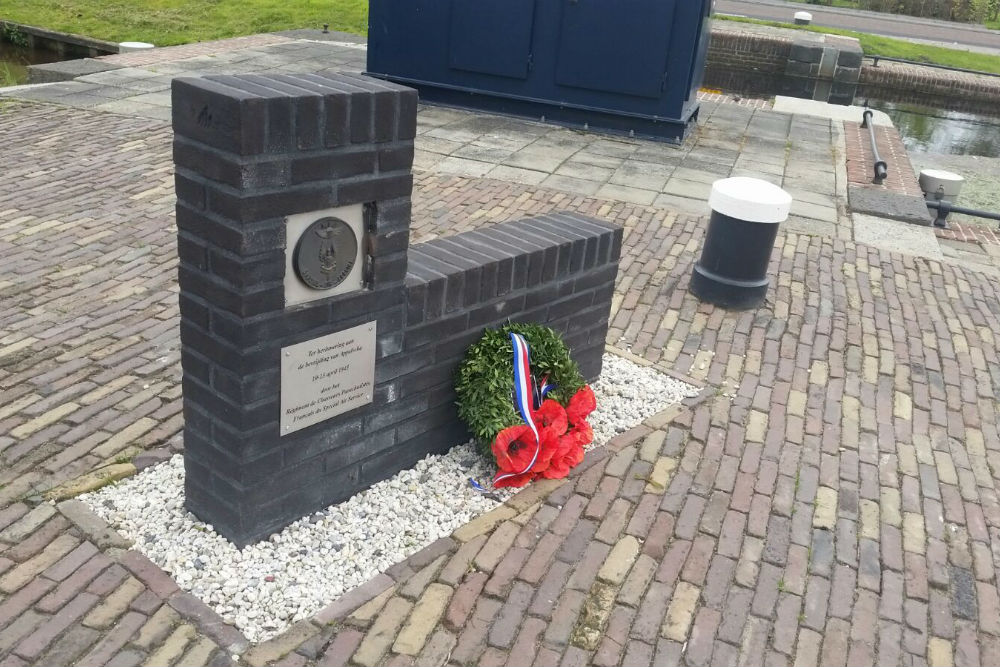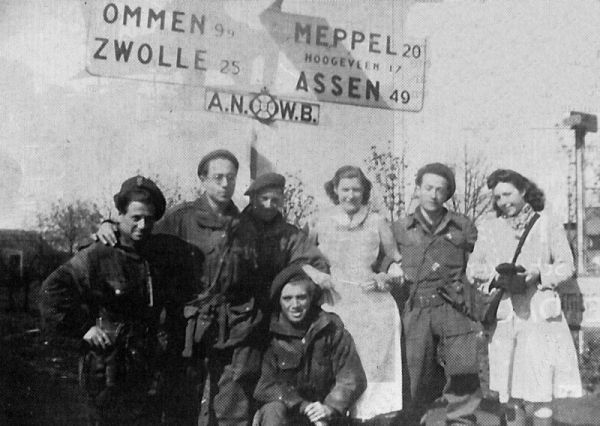War Memorial Stokersverlaatbrug Appelscha
THE BATTLES AT APPELSCHA - STOKERSVERLAATBRUG
About 60 parachutists are scattered over the border area of Drenthe and Friesland, in the municipalities of Ooststelllingwerf and Smilde. They are commanded by 33 year old Captain Pierre Sicaud. During the landing, Sicaud is injured. He gets a branch in his eye and is partially blind for three days. When studying the staff maps, he comes to the conclusion that his stick has landed in the wrong place. Sicaud decides to wait until dawn. The tired men go into shelter.
Since February 1945, a shelter has been located in the woods south of Appelscha that provides shelter for members of the Knokploeg Noord-Drenthe, founded in June 1944. The hideout is given the name of Prince Bernhard barracks. These resistance fighters receive military training from Sergeant Willem van de Veer. Van der Veer is a member of No. 2 Dutch Troop of no. 10 (Inter Allied) Commando. With a few other commandos and a Belgian SAS officer he was dropped in the Northern Netherlands in October 1944 to give support to the resistance. In the night of 7 to 8 April they will hold an exercise in the woods of Appelscha. By daybreak they find Captain Sicaud's group sleeping in the woods. Initially they consider them Germans. When it turns out that they are French paratroopers, they are housed in the Prins Bernhard barracks. Resistance fighters and paratroopers go
then looking for stray paras who bring them to camp
On Tuesday, April 10, the French in the Rooks farm are preparing to advance to the northern Opsterlandse Compagnonsvaart. Captain Sicaud has decided to occupy the Stokersverlaatbrug, located to the west of Appelscha. This forms an important connection between Southeast Friesland and Drenthe. Lieutenant Duno, with fourteen paras, occupied the unguarded bridge at around 6:00 am. It is easy to defend the bridge and there is a fairly large forest less than 2 km away which can provide some help in case of difficulties. The other French soon joined them. Scaffolding is being set up around the bridge while a number of French take up positions on the roof of the nearby Mulder flour factory.
At 9 am a German vehicle arrives from the direction of Appelscha. This is taken under fire and the occupants are killed. Later in the day, a group of German soldiers approaching the bridge is captured. All day long, the paras in the area search for other paratroopers, with the help of the population. In the evening the French retreat to the woods with their prisoners of war.
The next day, Wednesday, April 11, they occupied the bridge again. Around ten o'clock another German vehicle appears and is switched off. At one o'clock the Germans attack the bridge in vain. During the day, the paras find the escapees from Lieutenant Vidoni's stick. By noon a bus with German soldiers approaches along the south side of the canal. The bus is forced to stop and fired upon. One man is killed, a few are injured and taken prisoner with the rest. In the late afternoon, a German passenger car approaches from the Bruggelaan. The driver suspects danger when seeing the previously destroyed car. When he wants to stop the car, it is fired upon. Some Germans are killed, the survivors surrender. Allegedly, this includes a seriously injured officer who carries a list of names of resistance fighters who are locked up in the Groningen prison. The people on the list must be shot.
On Thursday morning, April 12, the French return to the bridge. Because the fighting is going on longer than planned, the French are running out of ammunition and food. They ask for a supplement via their radio connection. Two Typhoons then drop supplies. There are also landmines with which barriers are now being built on the access roads to the bridge.
There are several lectures on the fighting at the Stokersverlaat bridge. Mr. J. van der Walle, originally from Appelscha, has been researching the fighting in Appelscha for two years. It is his lecture that has been followed here.
Do you have more information about this location? Inform us!
Source
- Text: Cornelis Reijntjes
- Photos: Cornelis Reijntjes
- Amherst, Roger Flammand
Nearby
Museum
Point of interest
Monument
- War Memorial Appelscha - Appelscha
- Memorial Marinus Van Emst - Appelscha
- Monument Free Socialists - Appelscha
Cemetery
- Dutch War Graves Oosterwolde - Oosterwolde
- Commonwealth War Graves Hoogersmilde - Hoogersmilde
- Dutch War Graves Hoogersmilde - Hoogersmilde
Remembrance Stone
- Stumbling Stone Rijksweg 85 - Smilde
- Stumbling Stone Veenhoopsweg 58 - Smilde
- Stumbling Stones Veenhoopsweg 49 - Smilde





